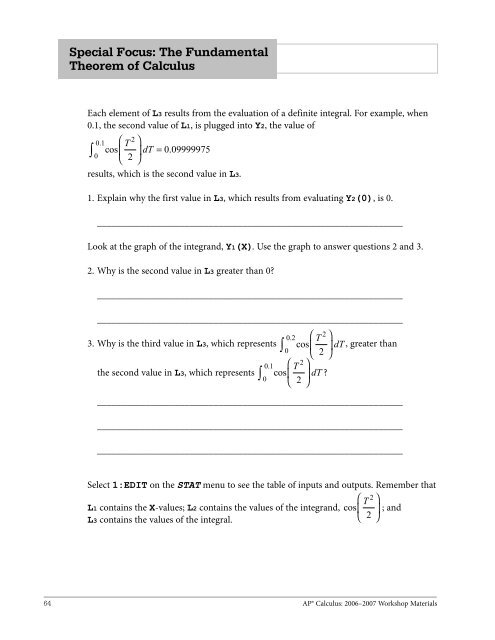AP Calculus
Create successful ePaper yourself
Turn your PDF publications into a flip-book with our unique Google optimized e-Paper software.
Special Focus: The Fundamental<br />
Theorem of <strong>Calculus</strong><br />
Each element of L3 results from the evaluation of a definite integral. For example, when<br />
0.1, the second value of L1, is plugged into Y2, the value of<br />
∫<br />
⎛ 2 ⎞<br />
cos ⎜ ⎟ dT = 0.<br />
09999975<br />
⎝ 2 ⎠<br />
0. 1 T<br />
0<br />
results, which is the second value in L3.<br />
1. Explain why the first value in L3, which results from evaluating Y2(0), is 0.<br />
_______________________________________________________________<br />
Look at the graph of the integrand, Y1(X). Use the graph to answer questions 2 and 3.<br />
2. Why is the second value in L3 greater than 0?<br />
_______________________________________________________________<br />
_______________________________________________________________<br />
0. 2 ⎛ 2<br />
T ⎞<br />
3. Why is the third value in L3, which represents<br />
∫ cos⎜<br />
⎟ dT , greater than<br />
0<br />
⎝ 2 ⎠<br />
0. 1 ⎛ 2<br />
T ⎞<br />
the second value in L3, which represents ∫ cos⎜<br />
⎟ dT ?<br />
0<br />
⎝ 2 ⎠<br />
_______________________________________________________________<br />
_______________________________________________________________<br />
_______________________________________________________________<br />
Select 1:EDIT on the STAT menu to see the table of inputs and outputs. Remember that<br />
⎛<br />
L1 contains the X-values; L2 contains the values of the integrand, cos T 2 ⎞<br />
⎜ ⎟ ; and<br />
⎝ 2<br />
L3 contains the values of the integral.<br />
⎠<br />
64<br />
<strong>AP</strong>® <strong>Calculus</strong>: 2006–2007 Workshop Materials


